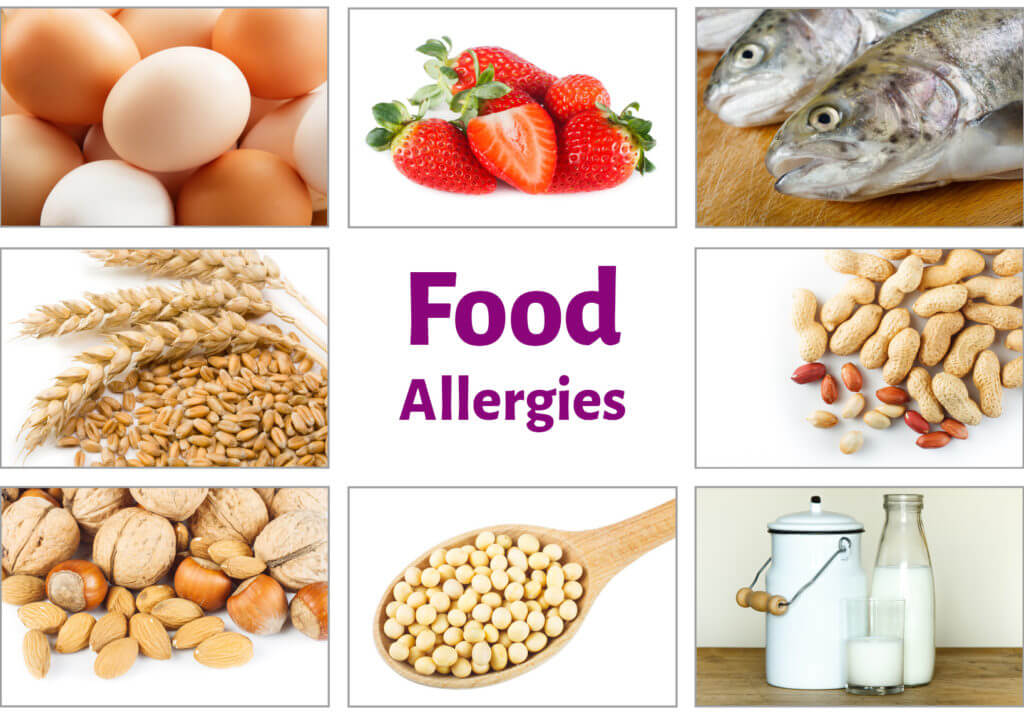How do I know if I have a food allergy?
The most common symptoms of food allergy are chronic upset stomach, bloating, diarrhea, and nausea. Other less common symptoms are chronic rashes, severe persistent eczema, hives, itchy throat, or swelling in the mouth or throat. The rarest, but most severe, food allergy reaction is anaphylaxis. Anaphylaxis is a life-threatening reaction where, within minutes of being exposed to the allergic substance, your blood pressure drops, you feel dizzy like you are going to faint, your throat or airway swells shut, and it is hard to breathe. Peanuts, tree nuts, and shellfish are the most common foods that can cause anaphylaxis.
What are the most common food allergies?
The most common foods that can cause allergies are wheat, egg, soy, milk, fish, shellfish, peanuts, tree nuts, and almonds.
How do food allergies develop?
Food allergies develop in individuals that have a genetic predisposition. Food allergies can develop at any time in life. If there is a strong genetic predisposition, the food allergy may be present at birth or develop in early childhood. For example, infants can be allergic to human or cow milk. Some toddlers and young children can develop an allergy to peanuts or tree-nuts if they were not exposed to these nuts early enough in life. It is now recommended that infants whose family members have peanut allergy be introduced to peanuts between 6-12 months of age (1). Adults who develop a food allergy usually were eating that food every day for a long time. Such is often the case with wheat, soy, egg, and milk. Foods that are eaten every now and again are usually not the cause of chronic daily allergy symptoms.
How do you test for food allergies?
We can test for allergies with skin tests and/or blood tests. The skin tests are generally more accurate. You can also try a food elimination diet if you suspect a food allergy, although this requires more time and effort. This diet systematically cuts out different foods to help you narrow down what is causing the allergy. Here is a link to a reputable food elimination diet: http://www.lrfpc.com/forms/allergy/lrfpc_allergy_diet.pdf
How do you treat food allergies? Are they curable?
Food allergies are mainly treated through avoidance. If a person has a life-threatening reaction to a food, it should be strictly avoided. It is also a good idea for such a person to carry an Epi-pen to reverse such a reaction should they accidentally eat the food. Children will often grow out of their food allergies, like peanut, milk, and egg. When your child with food allergies is older you can take them to an Allergist’s office to see if they are still allergic. There they can eat the food and be monitored for reactions. If the reactions occur, they can be treated there in the clinic.
If the food allergy symptoms are not life-threatening, like chronic abdominal pain or rash, then strict avoidance is also used. However, after not eating the food for 2 months, you can attempt to introduce it back into the diet 1-2x a week. Often, when the food is then only eaten 1-2x a week, the allergy symptoms will not recur. However, if the symptoms do recur, then the food should be avoided indefinitely.
Are gluten insensitivity/intolerance or Celiac disease food allergies?
No, these illnesses are not allergies and are not detected with allergy tests.
Resources:
- Fleischer, D. Introducing highly allergenic foods to infants and children. Up-to-date. Accessed 4/8/16. http://www.uptodate.com.xlib1.intermountain.net/contents/introducing-highly-allergenic-foods-to-infants-and-children?source=search_result&search=peanut+allergy&selectedTitle=6~59#H2497362924



